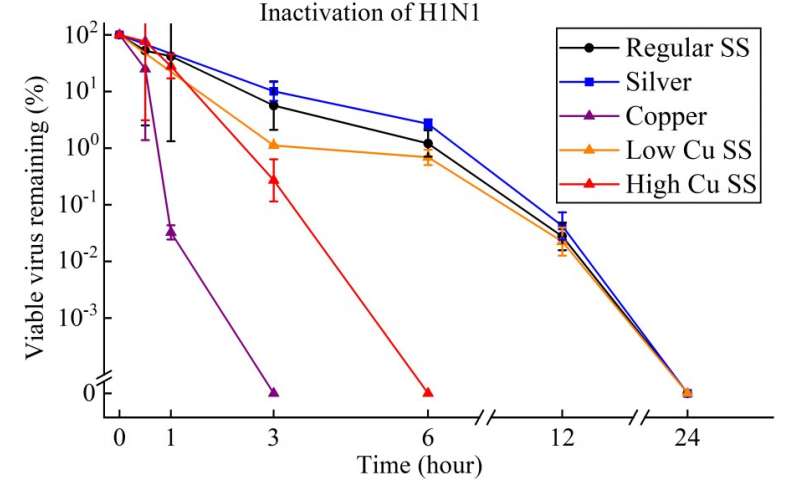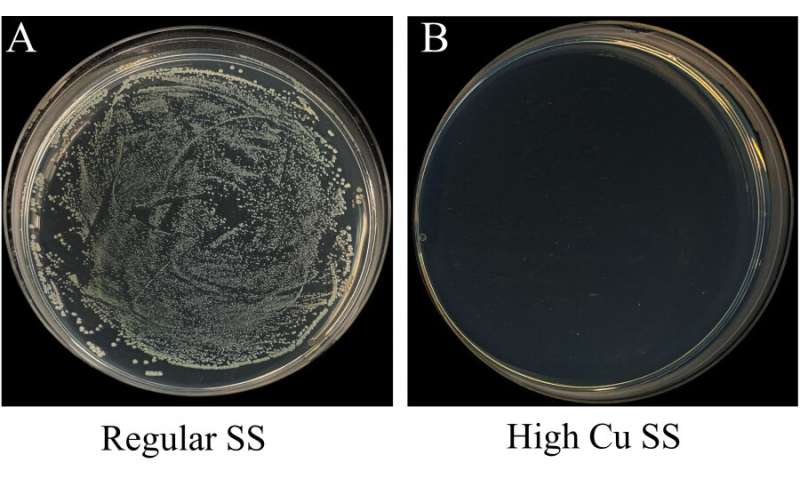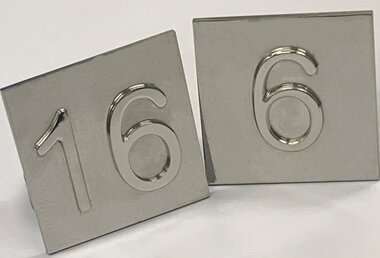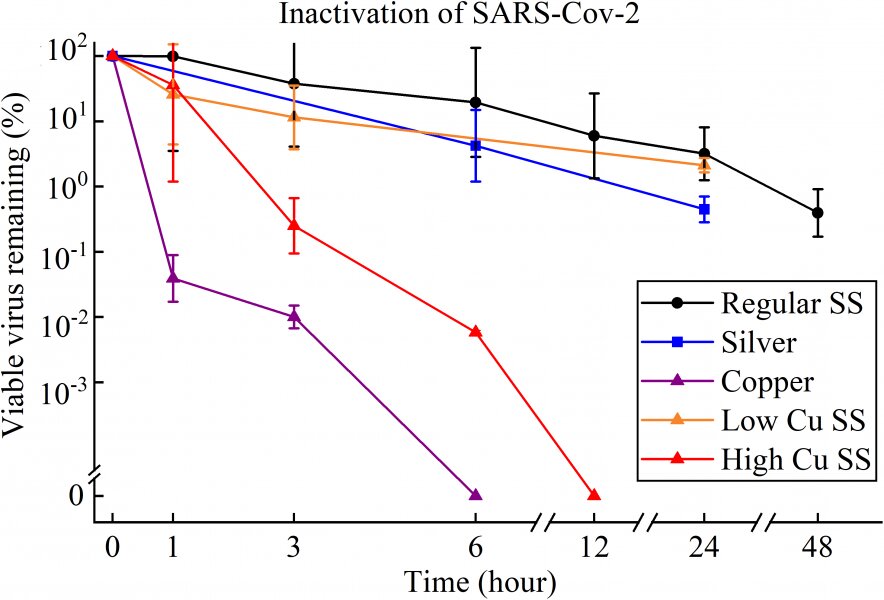Figure 1. Viability of SARS-Cov-2 on surfaces of various metals (each point is the average value of three measurements). Credit: University of Hong Kong
The team led by Professor Mingxin HUANG from the Department of Mechanical Engineering of the Faculty of Engineering of the University of Hong Kong (HKU), in collaboration with the research team of Professor Leo Lit Man POON at the Immunity Center and Infection Control at the School of Medicine of HKU, has made significant breakthroughs in producing the first anti-COVID-19 stainless steel that kills severe acute respiratory syndrome coronavirus 2 (SARS-CoV-2) on its surface. Anti-COVID-19 stainless steel can also inactivate H1N1 virus and E.coli on its surface.
The findings were published in the chemical engineering journal on November 25, 2021 in an article titled “Pathogenic stainless steel fighting COVID-19”.
Stainless steel is one of the most widely used materials in many public spaces and hygiene facilities, but it does not have inherent antimicrobial properties. Additionally, SARS-CoV-2 exhibits strong stability on ordinary stainless steel surfaces, with viable viruses detected even after three days. This has undoubtedly created a high possibility of virus transmission among people using these areas and facilities.
“In this latest breakthrough, the inactivation of pathogenic microbes (specifically SARS-CoV-2) on the surface of stainless steel is achieved by adjusting the chemical composition and microstructure of ordinary stainless steel. The breakthrough has also found interesting points on Ag and Cu as alloying elements to prepare anti-pathogenic stainless steel (Fig. 1–3).Pathogenic viruses such as H1N1 and SARS-CoV-2 show good stability on the surface of pure stainless steel containing Ag and Cu with low Cu content (e.g. ≤ 5wt%) but are rapidly inactivated on the surface of pure Cu and stainless steel containing Cu high Cu content (e.g., ≥10wt%),” Prof. Mingxin Huang said.
-

Figure 2. Viability of H1N1 on surfaces of various metals (each point is the average value of three measurements). Credit: University of Hong Kong
-

Figure 3. Photos of typical bacterial colonies on A) regular SS and B) high Cu SS (20 wt%). Credit: University of Hong Kong
-

Figure 4. Lift buttons made from high Cu SS (20 wt%) by PM technology. Credit: University of Hong Kong
A patent (Patent Cooperation Treaty (PCT) type) has been filed for the research results. The team liaised with industry partners to generate prototypes of stainless steel public products such as elevator buttons, door handles and handrails for further testing and trials. For initial demonstration purposes, “floor buttons” used in elevators have been successfully fabricated using high Cu (20 wt%) stainless steel (Fig. 4).
“Massive copper-rich precipitates are permanently present in the stainless steel matrix. Thus, this anti-COVID-19 stainless steel can chronically inactivate pathogenic microbes even if its surface is continuously damaged,” said Mr. Litao LIU, the first author of the study. journal article and a doctorate. student supervised by Professor Huang.
“Current anti-COVID-19 stainless steel can be mass-produced using existing mature technologies. They can replace some of the high-touch stainless steel products in public spaces to reduce the risk of accidental infection and combat against the COVID-19 pandemic,” Professor Huang added.
Moderna says contaminated COVID vaccines sent to Japan contained steel
LT Liu et al, Anti-Pathogen Stainless Steel Fighting COVID-19, chemical engineering journal (2021). DOI: 10.1016/j.cej.2021.133783
Provided by the University of Hong Kong
Quote: Engineers develop first anti-COVID-19 stainless steel (December 9, 2021) Retrieved March 25, 2022 from https://phys.org/news/2021-12-anti-covid-stainless-steel.html
This document is subject to copyright. Except for fair use for purposes of private study or research, no part may be reproduced without written permission. The content is provided for information only.

